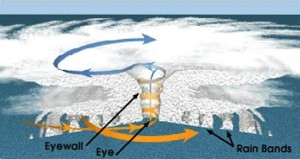Scientists claim that powerful cyclones are likely to be produced by pollution in air
Thursday, November 3rd, 2011 8:05:42 by Zeeshan Gohar
A study at University of Virginia in Charlottesville has suggested that pollution in the atmosphere is a potential reason to generate cyclones in South Asia. The study was conducted by
Dr. Amato Evan and his colleagues in the university. They believe that a thick layer of pollution over the Indian Ocean may be creating atmospheric conditions that promote fierce cyclones
The scientists assume that the August 2007 flooding in Karachi was a result of the aftermath of a tropical cyclone and pollution may increase the likelihood of such storms. The study also
found that the powerful tropical cyclones are increasingly commonly as a result of pollution and they can cause large numbers of deaths and massive property damage around the Arabian Sea.
The research claims that analysis of the intensity of storms between 1979 and 2010 suggests that thick layers of haze have created atmospheric conditions which intensify cyclones and increase
the chances to reach land. The fine aerosol emissions has increased six times locally from forest fires since the 1930s as a result of domestic heating and diesel use and has created a layer of pollution 3km thick over the Indian Ocean.
Dr Amato Evan and his colleagues have suggested that the giant pollution cloud reduces the surface temperature of the Arabian Sea, which reduces wind shear and triggers the formation of
more powerful cyclones.
Dr Evans spoke about their finindings, “We have found a clear connection between human activity and changes in atmospheric conditions that create favourable conditions for the formation
of large tropical cyclones. In my mind that’s a big step forward. Every analysis we did pointed in the same direction. We only have 30 years of data, but we have used data from multiple different sources, so I’m confident our results are robust.”
According to the study findings, in the period 1979-96, the wind sheer had dropped from an average of 11 mps to eight mps in 1997-2010. The research team led by Evan used three sets of
data on the maximum wind speed of the 10 tropical cyclones that occurred in the region between 1979 and 1996 and the 10 that developed between 1997 and 2010.
Short URL: https://www.newspakistan.pk/?p=2658

















